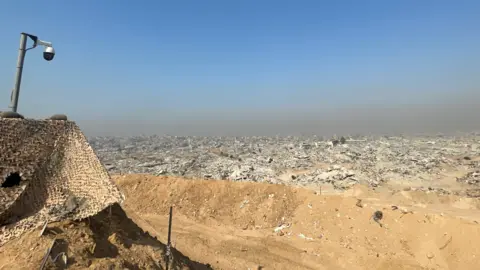From an embankment overlooking Gaza City, there's no hiding what this war has done.
The Gaza of maps and memories is gone, replaced by a monochrome landscape of rubble stretching flat and still for 180 degrees, from Beit Hanoun on one side to Gaza City on the other.
Beyond the distant shapes of buildings still standing inside Gaza City, there's almost nothing left to orient you here, or identify the neighborhoods that once held tens of thousands of people.
This was one of the first areas Israeli ground troops entered in the early weeks of the war. Since then they have been back multiple times, as Hamas regrouped around its strongholds in the area.
Israel does not allow news organizations to report independently from Gaza. Today it took a group of journalists, including the BBC, into the area of the Strip occupied by Israeli forces.
The brief visit was highly controlled and offered no access to Palestinians, or other areas of Gaza.
Military censorship laws in Israel mean that military personnel were shown our material before publication. The BBC maintained editorial control of this report at all times.

Asked about the level of destruction in the area we visited, Israeli military spokesman Nadav Shoshani said it was not a goal. The goal is to combat terrorists. Almost every house had a tunnel shaft or was booby-trapped or had an RPG or sniper station, he said.
Since the outbreak of hostilities on October 7, significant casualties have been reported, with more than 68,000 Gazans killed according to local health officials.
The next stage of the US-led peace plan requires Hamas to disarm and relinquish power to a newly formed administration. However, ongoing violence and uncertainty pose serious questions about the region's future.



















